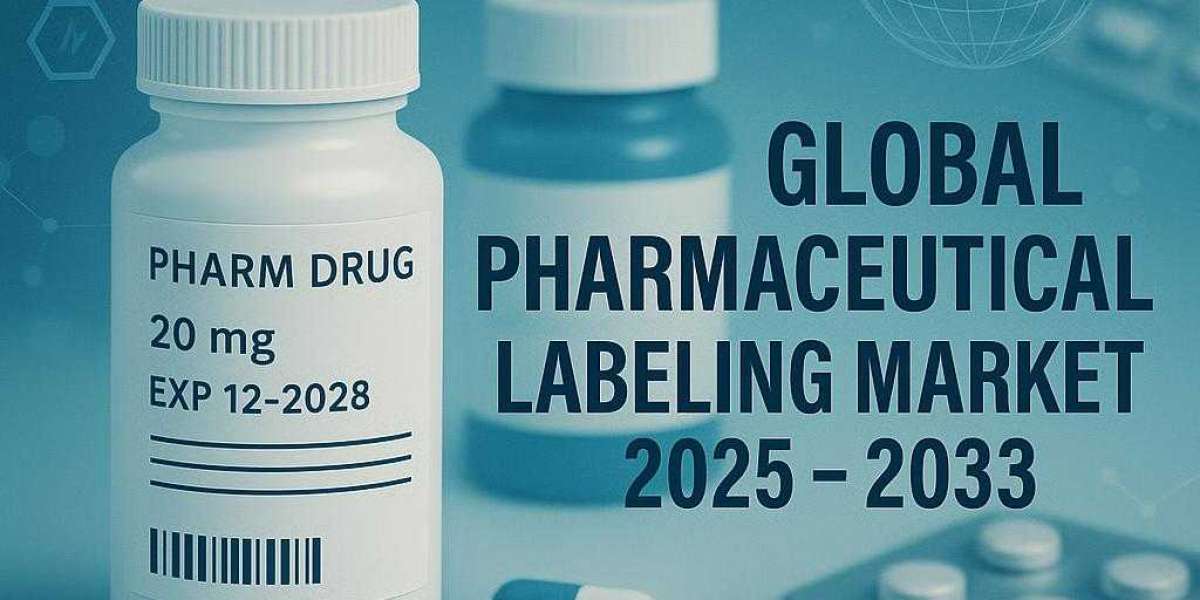The global pharmaceutical labeling market reached USD 6.3 billion in 2024 and is projected to expand to USD 9.8 billion by 2033, growing at a 5% CAGR (2025–2033). Growth is driven by stricter regulatory compliance, rising drug approvals, globalization of pharma supply chains, advances in smart labeling and printing technologies, and a stronger focus on patient-centric, anti-counterfeit, and traceability solutions.
Study Assumption Years
- BASE YEAR: 2024
- HISTORICAL YEAR: 2019–2024
- FORECAST YEAR: 2025–2033
Pharmaceutical Labeling Market — Key Takeaways
- Global market size was USD 6.3 billion in 2024, forecast to reach USD 9.8 billion by 2033 at 5% CAGR (2025–2033).
- North America dominates due to a mature pharmaceutical sector, strict regulation, and rapid adoption of smart labeling.
- Pressure-Sensitive Label is the leading label-type segment, favored for ease of application and versatility.
- Polymer Film leads materials, offering durability, print clarity, and environmental resistance for critical drug information.
- Instructional and functional labels (tamper-evident, QR/RFID) are expanding as patient-centric and anti-counterfeit needs grow.
- Bottles represent the largest end-use segment due to surface area and packaging compatibility.
Market Growth Factors
1 - Technological Advancements Smart Labeling
Improved printing technologies and smart-label integrations are central to market expansion. Digital and high-resolution flexographic printing allow complex, multi-language, and variable-data labels - essential for global launches and regulatory compliance. Smart features such as QR codes, NFC, RFID, serialization, and tamper-evident elements elevate traceability across the supply chain and enhance patient engagement by enabling access to drug information, usage videos, and authentication checks. Polymer films’ superior printability and durability further enable advanced security inks, microtext, and overt/covert anti-counterfeiting elements. Manufacturers are investing in in-line, automated labeling machines that reduce human error, speed production, and shorten time-to-market for newly approved drugs. These innovations respond directly to pharmaceutical companies’ needs for accuracy, traceability, and brand protection while supporting personalized medicine trends where label variability and patient-specific instructions are increasingly common.
2 - Regulatory Compliance Safety
Stringent regulation from agencies like the FDA and EMA is a principal growth engine. Labels are legally required to carry accurate dosage, contraindication, storage, and safety information; evolving guidance increases label complexity and drives demand for reliable, compliant solutions. Non-compliance poses high penalties, pushing pharma firms to partner with specialized label providers capable of navigating country-specific language requirements and frequent regulatory updates. Serialization and tamper-evident labeling have become regulatory expectations in many markets to prevent counterfeiting and ensure supply-chain integrity. The need for standardized, multilingual labeling for global distribution also compels the adoption of flexible label materials and printing methods, such as pressure-sensitive labels and polymer films that support long-lasting legibility under various storage conditions. As regulatory scrutiny grows, outsourced expert labeling services and compliance-focused innovations will continue to capture market share.
3 - Rising Drug Approvals, Globalization Patient-Centric Demand
The expanding pipeline of novel drugs, generics, and biologics raises labeling volume and complexity. Each approved product requires accurate, up-to-date labeling at launch — fueling demand for scalable labeling solutions and multilingual versions for global markets. Globalization forces harmonized but localized labels that satisfy diverse regulatory frameworks and cultural requirements. Patient-centric care trends boost demand for clearer, user-friendly instructional labels that improve adherence and reduce medication errors. Functional labels—featuring tamper evidence, QR codes, and on-package digital links—help engage patients directly and offer supplemental guidance beyond print. Counterfeit concerns and increased cold-chain distribution for biologics also favor durable materials like polymer films and robust bottle labeling solutions. Combined, higher product throughput, cross-border launches, and emphasis on safety and usability underpin steady market growth through 2033.
Request for a sample copy of this report:
https://www.imarcgroup.com/pharmaceutical-labeling-market/requestsample
Market Segmentation
Breakup by Label Type
- Pressure-Sensitive Label
Pressure-sensitive labels stick to a wide range of packaging without heat or solvent, offering fast application, customization, and compatibility with variable-data printing for traceability and branding. - Glue-Applied Label
Glue-applied labels use adhesive application for secure attachment, suitable for irregular surfaces and large-scale production that requires robust adhesion under varied storage conditions. - Sleeve Label
Sleeve labels conform to container contours, provide 360-degree branding and tamper-evidence, and are ideal for promotional and full-body decoration on diverse package shapes. - In-Mold Label
In-mold labels are integrated during container molding, delivering high durability, tamper resistance, and permanent graphics suitable for long shelf-life pharmaceutical products. - Others
This category covers alternative label types and emerging formats not classified above, including speciality and hybrid labels tailored for niche pharmaceutical applications.
Breakup by Material
- Paper
Paper labels offer cost-effectiveness and recyclability for standard pharmaceutical packaging, suitable for clear printing but typically less durable in moist or cold environments. - Polymer Film
Polymer films deliver superior durability, moisture and chemical resistance, excellent print clarity, and compatibility with smart inks and security features for high-integrity pharmaceutical labeling. - Others
Includes composite, coated, and specialty substrates that meet unique regulatory, durability, or environmental requirements in specific pharmaceutical applications.
Breakup by Application
- Instructional Label
Instructional labels convey dosage, administration, storage, and safety directions clearly, ensuring patient compliance, regulatory conformity, and reduced medication errors in clinical and consumer settings. - Decorative Label
Decorative labels support brand identity and shelf appeal through logos, color schemes, and designs while balancing aesthetics with the requirement for clear regulatory information. - Functional Label
Functional labels incorporate tamper-evident seals, authentication elements, QR codes, RFID, and serialization to enhance traceability, security, and patient engagement across the supply chain. - Promotional Label
Promotional labels are used for marketing, limited editions, or campaigns—adding messaging or graphics to stimulate uptake while still meeting mandatory information requirements. - Others
Captures application types beyond the main categories, including specialty instructional or hybrid labels tailored to specific pharmaceutical product needs.
Breakup by End Use
- Bottles
Bottles provide abundant label surface area, superior protection from environmental factors, compatibility with child-resistant closures, and broad applicability across liquid and solid dosage forms. - Blister Packs
Blister packs offer unit-dose protection and clear labeling for each tablet or capsule—ideal for adherence, tamper evidence, and patient instruction in outpatient settings. - Parenteral Containers
Parenteral containers require durable, high-clarity labels that can withstand sterilization processes and provide crucial dosing and handling information for injectable products. - Pre-Fillable Syringes
pre-fillable syringes demand compact, highly legible labels with tamper-evidence and precise dosing information to support safe administration and cold-chain stability. - Pre-Fillable Inhalers
Inhaler labeling focuses on clear usage instructions, dose counters, and safety information while withstanding mechanical abrasion and environmental exposure during use. - Pouches
Flexible pouches need adaptable labels that adhere to pliable surfaces while preserving essential drug information and maintaining traceability during transit. - Others
Encompasses remaining end-use packaging forms that require customized labeling solutions for specific pharmaceutical formats.
Breakup by Region (ONLY BULLETS — NO EXPLANATION; sub-bullets included)
- North America
- North America
- Europe
- Europe
- Asia Pacific
- Asia Pacific
- Latin America
- Latin America
- Middle East and Africa
- Middle East and Africa
Regional Insights
North America dominates the pharmaceutical labeling market thanks to a mature pharma industry, rigorous regulatory frameworks (e.g., FDA), rapid uptake of serialization and smart labeling, and strong RD activity. These factors, combined with demand for secure, patient-centric, and multilingual labeling solutions, drive investment in polymer films, pressure-sensitive, and functional labels - supporting sustained market expansion and technology adoption.
Recent Developments News
Recent activity highlights consolidation and security-focused innovation. Jet Label’s acquisition by ProMach reinforces capacity expansion and vertical integration in label printing and converting, enhancing production scale and service breadth. Avery Dennison expanded its tamper-evident and anti-counterfeiting portfolio - destructible labels, box damage films, and void labels - to combat drug counterfeiting and strengthen product authentication. Together, these moves indicate industry emphasis on bolstering supply-chain security, increasing anti-counterfeit offerings, and scaling manufacturing capabilities to support growing global demand for compliant, patient-centric, and technology-enabled labeling solutions.
Key Players
- 3M
- Avery Dennison Corporation
- Bemis
- CCL Industries
- Essentra
- LINTEC
- SATO Holdings
- Advanced Labels
- Edwards Label
- Jet Label
- Consolidated Label
- Axon
- Clabro Label
- Classic Label
- Maverick Label
- Metro Label
- Progressive Label
- MCC Label
- Mercian Labels
- Taylor Label
Ask Analyst for Customization:
https://www.imarcgroup.com/request?type=reportid=1559flag=C
If you require any specific information that is not covered currently within the scope of the report, we will provide the same as part of the customization.
About Us:
IMARC Group is a global management consulting firm that helps the world’s most ambitious changemakers to create a lasting impact. The company provides a comprehensive suite of market entry and expansion services. IMARC offerings include a thorough market assessment, feasibility studies, company incorporation assistance, factory setup support, regulatory approvals and licensing navigation, branding, marketing and sales strategies, competitive landscape, benchmarking analyses, pricing and cost research, and procurement research.
Contact Us:
IMARC Group
134 N 4th St. Brooklyn, NY 11249, USA
Email: sales@imarcgroup.com
Tel No:(D) +91 120 433 0800
United States: (+1-201971-6302)














